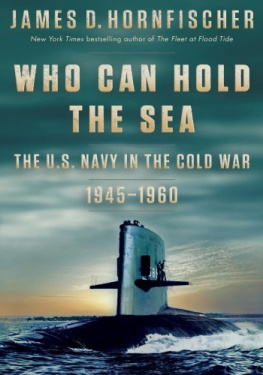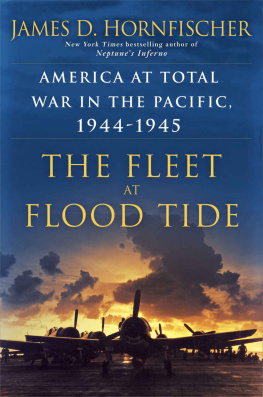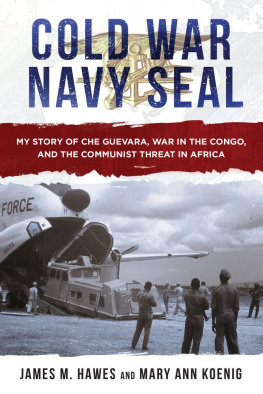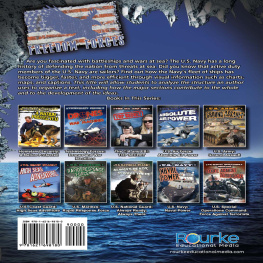Copyright 2022 by The Estate of James D. Hornfischer All rights reserved. Published in the United States by Bantam Books, an imprint of Random House, a division of Penguin Random House LLC, New York. BANTAM BOOKS and the HOUSE colophon are registered trademarks of Penguin Random House LLC. Image credits are located on . LIBRARY OF CONGRESS CATALOGING-IN-PUBLICATION DATA Names: Hornfischer, James D., author. Title: Who can hold the sea: the U.S. Navy in the Cold War, 19451960 / James D. Hornfischer. Other titles: U.S. Navy in the Cold War, 19451960 Identifiers: LCCN 2021043097 (print) | LCCN 2021043098 (ebook) | ISBN 9780399178641 (hardcover) | ISBN 9780399178658 (ebook) Subjects: LCSH: United States. NavyHistory20th century. | Sea-powerUnited StatesHistory20th century. | United StatesHistory, Naval20th century. | World politics1945-1989. | Cold War. Classification: LCC VA58.4 .H67 2022 (print) | LCC VA58.4 (ebook) | DDC 359.00973dc23 LC record available at lccn.loc.gov/2021043097 LC ebook record available at lccn.loc.gov/2021043098 Ebook ISBN9780399178658 randomhousebooks.com Book design by Virginia Norey, adapted for ebook Cover design: Carlos Beltrn Cover photograph: USS Scorpion (SSN-589) courtesy of the Naval History & Heritage Command ep_prh_6.0_139875643_c0_r0
Contents
Dec. 1945: Halsey in New York / Controversy over defense unification, Navy roles and missions / Can fleets actually survive an atomic bomb? Feb. 9, 1946: Stalin speech compels diplomat George F. Kennan to write the Long Telegram to the State Department, urging a policy of vigilant containment of USSR; Defense Secretary James Forrestal embraces Kennans X article / World Communism and its aims Churchill in Missouri / Early 1947: Trumans anticommunism / Forrestal saves the Navy / April 1946: Adm. Mitscher returns / USS Missouri visits the Med / April 22: Atlantic Fleet carrier exercise / The politics of alliance, 1946 / The atomic playboy gets ready to blast Bikini May 1946: preparing the target fleet / Adm. Blandy: bomb away / Operation Crossroads: two bombs over an anchorage The face of Armageddon: reckoning with radiation / Soviet observers agonistes / American atomic monopoly / Mitscher stonewalls the Brits / U.S. Sixth Fleet established at Naples to patrol the Mediterranean / Sept. 1946: The FBI sicced on Henry A. Wallace / Feb. 3, 1947: Marc Mitscher dies Adm. Conolly goes to London / Jan. 1947: Trumans State of the Union / Forrestals bargain / Crisis in the Med / Soviets in the Middle East / Truman to Congress, March 12, 1947: U.S. must oppose subjugation by armed minorities or by outside pressures / Feb. 1947: Britain quits Greece, Turkey; U.S. aid flows / July 1947: Kennans X article published in The Atlantic / Crossroads evaluated; Bikini scientific survey Sept. 6, 1947: a carrier launches a V-2 / The Navy wants a nuke / Show of force / A fleet commander meets the pope / Spiritual commitments: Can a Communist be a good Catholic? / Charioteer and other war plans / March 1948: Nimitz retires and reports / Keel laid for CVA-58, aka the supercarrier USS United States , at Newport News / Berlin crisis begins / James Forrestals decline Facing the Russians in Europe, and the doomsday option / Showdown over Berlin / Soviets build submarines / The B-36 bomber controversy / Dec. 15, 1948: Alger Hiss indicted / Anticommunism as blood sport / Witch hunt or protecting secrets? April 4, 1949: NATO established / Louis Johnsons Pentagon / James Forrestals hospitalization / May 22, 1949: Forrestal dies, said to be a suicide / Navy inquiry absolves its psychiatrists of responsibility but fails even to investigate the cause Origins of atomic propulsion, 19461949 / Improving upon the Germans / Capt. Rickover goes to work / Capt. Roy Benson, at New London, explores the science of undersea warfare; underwater acoustics and the sonar equation / Cochino , Tusk , and Corsair sortie for an exercise in the Norwegian Sea / Fire! Aug. 25, 1949: the ordeal of the USS Cochino in the Norwegian Sea / The Soviets are provoked Sept. 3, 1949: U.S. aerial snoopers detect Soviet atomic weapon test / U.S. domestic politics unsettled by McCarthyism and fears of the Soviet bomb / Arleigh Burke, superstar, vs. the B-36, the billion-dollar blunder / Navy morale plunges / Oct. 1949: Arthur Radford vs. the Air Force / Adm. Denfeld relieved / Forrest Sherman becomes CNO / China goes red / George Marshall, Communist? / Oct. 25, 1949: on Quemoy, Chiang routs Mao and plans for 1950 / Truman slashes the fleet / Soviets covet a unified Korea, destabilize South Korea Dec. 1949: as a naval war looms, Louis Johnson dismisses the Navy / NSC 68, a design for world order / Jan. 12, 1950: Achesons blunder / June 13, 1950: Dulles forswears isolation / June 25, 1950: North Korea invades South / U.S. Seventh Fleet prepares for war July 3, 1950: Task Force 77 carrier strikes begin / Developing the first carrier-based jets / Army rushes to Korea / Gen. Dean is overrun / Amphibious landing off Phohang Desperate straits in the Pusan perimeter / Marines muster a brigade / July 19, 1950: First Marine Division leadership arrives in Tokyo, greets MacArthur / Planning an amphibious offensive / Walton Walker holds on, issues stand or die order / Marines arrive / Aug. 4, 1950: Underwater demolition teams go to work blowing train tunnels / Carriers lend close air support / Facing concentrated North Korean assault, Marines hold the perimeter / Problems of tactical air control / Worse than defeat: bad publicity for the Air Force A great deal of sport: American aviators versus the North Korean Army / Aug. 23, 1950: naval movement: planning the invasion of Inchon / America versus world Communism: The test is here and now, MacArthur says / Sept. 15: Marines land at Inchon near Seoul, a masterstroke / Sept. 29: Seoul is liberated / North Korean offensive falters / USS Missouri goes to war / Soviet mining of Wonsans Harbor forces MacArthur to cancel second invasion Aerial reconnaissance searches for Soviet bomber bases / Tensions with China in the Taiwan Strait / Sept. 25, 1950: We cannot sit with folded hands: Chinese prepare to intervene / Oct. 18: Fearing U.S. invasion, Chinese send 18 divisions into Korea / MacArthur denies reality, though his spies know better / 380,000 Chinese troops are in North Korea First Marine Division reaches the Chosin Reservoir / Nov. 9: U.S. carrier pilots bag MiGs / MacArthur orders Gen. Almonds Tenth Corps north to the Yalu / Truman addresses the nuclear question Carrier planes and Marine Air Group help the Marines at Chosin to hold on / Nov. 30, 1950: Col. Davis springs Fox Company / Dec. 4, Radio Peking: The annihilation of the United States First Marine Division is only a matter of time / The ordeal of Ensign Jesse L. Brown / Dec. 9: First Marine Division reaches Hungnam for evacuation / Sept. 3: Walton Walker KIA Gen. Ridgway slows the Chinese push / Truman relieves MacArthur for insubordination / Jul. 10, 1951: cease-fire talks begin at Kaesong / July 22: Adm. Forrest Sherman, CNO, dies of a heart attack in Italy / Soviet fighter regiments enter Manchuria, blunting B-29 raids against Yalu bridges / Mid-Oct.: carrier airstrike on Kapsan kills hundreds of Communist leaders March 6, 1952: Chinese Communists accuse U.S. of waging biological warfare / De facto air war between U.S. and Soviets heats up over MiG Alley / July 14: USS Forrestal keel laid at Newport News / Aug. 6: fire on board USS Boxer / Sept. 10: Capt. Jesse G. Folmar becomes first pilot of a piston-driven naval fighter to destroy an enemy jet / Nov. 1: hydrogen bomb tested at Eniwetok Atoll / Nov. 4: Eisenhower sweeps to election landslide / Nov. 18: Navy pilot Royce Williams kills four MiG-15s over the Sea of Japan / Dec. 4: Eisenhower visits South Korea / July 27, 1953: Korean Armistice signed at Panmunjom May 31, 1953: Rickover triumphantin the Idaho desert, a naval atomic reactor comes to life / Jan. 17, 1955: Nautilus UNDERWAY ON NUCLEAR POWER U.S.-UK command relationships in the Mediterranean / Summer 1953: Project Solarium, a foreign policy exercise, guides Eisenhowers diplomacy / March 1954: French barely holding on in Indochina; U.S. Navy develops Operation Vulture, a scheme to use nuclear weapons against Communist forces / May 1: Eisenhower calls it crazy; its a no go / May 1954: the U.S. airlifts arms to Honduras in response to Soviet arms shipments to Guatemala / U.S. then embargoes arms sales and stages a coup that installs a new dictator in Guatemala / First Taiwan Strait Crisis / Huntington: A Transoceanic Navy / May 10, 1955: Arleigh Burke becomes CNO William Burdette McLean and the development of the Sidewinder missile / With a fire-and-forget missile, fighter pilots are only chauffeurs / Jet fighter design competitions lead to the F8U Crusader and the F4H Phantom / Regulus missiles give the Navy a heavy-attack capability / Development of the Polaris missile proceeds under the Navy Office of Special Projects and Rear Adm. William F. Red Raborn Feb. 1955: U.S. inks defense pact with Taiwan / 1954: recession threatens foundation of U.S. security / Summer 1956: Soviets arrange $200 billion arms sale to Egypt / U.S. declines to finance Aswan Dam construction on the Nile / July 26, 1956: Egypt seizes Suez Canal / British and French prepare military, naval response / Tactical innovation from Project Nobska / U-2 surveillance flights reveal Israeli mobilization, breach of arms agreements / Two hundred Royal Navy ships sortie to the Med / Oct. 29: Israeli troops and mechanized forces enter Egypts Sinai Peninsula, advancing to the banks of the canal / French and British paratroopers land a few days later, supported by aircraft from Royal Navy carriers / Nov. 4: Soviet troops enter Hungary to suppress protests / Sixth Fleet, augmented, moves into the eastern Mediterranean / Americans evacuated from Egypt and Israel / Eisenhower compels Eden to back down / Nautilus to the Pacific / Raborn and the Polaris project Capt. Anderson runs into Rickover / Aug. 19, 1957: Nautilus gets under way, departs New London headed for the Pacific / First foray under the ice / NATO naval exercise / Oct.: Soviets launch Sputnik into orbit / Eisenhower is determined to respond with an impressive technical feat / Capt. Anderson proposes a reverse Northwest Passage, going from Pacific to Atlantic via the North Poleunderwater / Eisenhower and Burke approve / June 9, 1958: Nautilus departs Seattle / Polar ice forces submarine to turn back / Reward for failure: three weeks in Hawaii / July: Nautilus tries again / Aug. 3, 1958: For the United States and the United States Navy, the North Pole! June 11, 1958: Faced with an uprising, the president of Lebanon requests U.S. assistance / July 16, 1958: Sixth Fleet lands Marines / Adm. Holloway, CINCNELM, executes Operation Blue Bat, goes ashore, helps clear roadblock / Jan. 1, 1959: Batista, Cubas dictator, forced to flee / Destroyers sold to West Germany / Aug. 23, 1958: Chinese bombard the Offshore Islands, Seventh Fleet intervenes / Taiwanese fighters shoot down, with heat-seeking missiles, five Red Chinese MiGs / Ike de-escalates / Oct. 6: the Chinese stand down / U.S. tries to establish Southeast Asia Treaty Organization alliance vs. China / Called a zoo of paper tigers, SEATO collapses Burke makes sure he has a good admiral in Omaha / Polaris adds punch to SIOP / CNO Ikes 41 for Freedom program adds twoscore boomers to the fleet / May 18, 1960: USS Archerfish begins Operation Sea Scan, mapping gravitational fields undersea / The ballistic missile submarine is the Navys newest capital ship Cruisers are fitted with Talos and Terrier surface-to-air missiles / Plans cooked up in 1956 to convert Iowa -class battleships to guided missile battleships find no traction / July 14, 1959: nuclear-powered guided missile cruiser USS Long Beach is commissioned USS George Washington carries out a demonstration launch of a Polaris A1 missile, and begins its first strategic-deterrence patrol Whosoever can hold the sea has command of everything. Themistocles,
Next page





